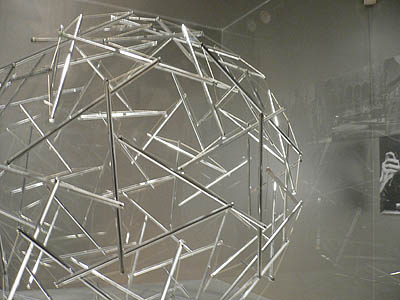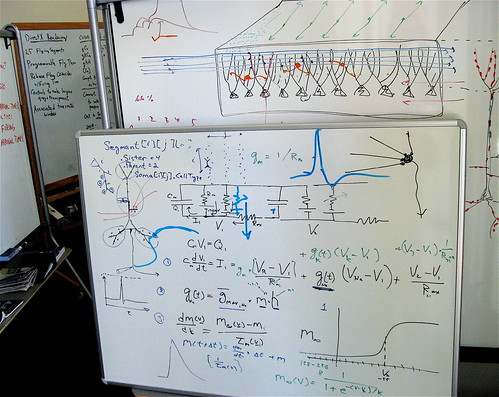This one is really neat:
This piece of robotic awesomeness come courtesy of Cornell University.
The starfish like robot starts out with no internal model of itself. It goes through a series of self-directed motions which it uses to figure out what kinds of pieces it has, where its joints are, how many limbs it has, how it can possibly move, etc. Then it uses the knowledge it has gained to figure out a way to walk, and it walks. When the engineers later remove a piece, it senses the lost portions, re-configures its self image, and tries to devise an alternate method of walking.
Monday, April 23, 2007
Robot of the Week! - Self Image
Posted by
Bill
at
6:50 PM
Labels:
cornell,
curiosity,
robot,
robot of the week,
self image,
starfish
![]()
Thursday, April 19, 2007
Printing Objects in Three Dimensions
I came across a great article today on Ars Technica about a do-it-yourself personal fabrication machine.
What's a fabrication machine? It's this:
Basically, Evan Malone, a mechanical engineering grad student at Cornell University, has designed a rapid prototyping 3D printer that you can build for yourself for under $3,000.00.
The article linked above points out that this is an equivalent cost range to early personal computing. I don't know how much this will bear out as an analogy, but if the flexibility, robustness and sophistication of this machine compounds anywhere near as quickly as those early computers did, this could well be one of the first signs of a true revolution in the way things are done!
Posted by
Bill
at
12:42 AM
Labels:
3d printing,
ars technica,
cornell,
early computing,
Evan Malone,
fab,
fabrication,
home,
printing objects,
rapid prototyping
![]()
Tuesday, April 17, 2007
Transparent Life TV!
Here's an experiment - I started writing this because I needed another outlet to toy with interesting ideas - the way I usually do this is in elaborate conversations with friends. My friend Eric and I have talked for a while about recording some of these conversations and seeing what we could do with them. Soooo - here's the first installment of A Transparent Life on Youtube:
It's at least 1980's Local PBS Affiliate Public Interest Interview Show quality, don't you think? :-P
I'll be posting more 10 minute segments of this as time goes on... hopefully you'll be entertained.
Posted by
Bill
at
6:10 PM
Labels:
Transparent life TV,
TV,
Youtube
![]()
Monday, April 16, 2007
Robot of the Week!: Sony Qrio Pitching
Pretty good overhand:
So far, most of the Japanese robots I've seen have really nailed showmanship in their movements. I love the way this one winds up before the pitch!
Posted by
Bill
at
7:15 PM
Labels:
ball,
pitch,
Qrio,
real robot renaissance,
robot of the week,
Sony,
throw
![]()
Friday, April 13, 2007
Mending the Scheme - Ben Franklin's warning!
With all the spectacle of wealth excreting semi-conscious software based juristic entities (still working on that name) that has gone on this week here, now seems like a good time to consult our old friend Benjamin Franklin for a word of caution:
"Whenever we attempt to mend the scheme of providence, we had need be very circumspect lest we do more harm than good."
- Benjamin Franklin, found in Benjamin Franklin: An American Life by Walter Isaacson

This picture of a painting of Benjamin Franklin linked to from A. Meyers' Flickr photostream, he owns the picture; made available under a creative commons license, some rights reserved.
Here's a nightmare scenario, as conceived by Charles Stross in his novel Accelerando. What if these weird, self-sufficient economic entities become self organizing and conscious, and able to guide their own further elaboration? The creatures I've been describing are like caveman versions of the entities which come to be known in his book as the Vile Offspring. In the book, the Vile Offspring are post-human intelligent entities evolved from a variety of Artificial and Human Intelligence combinations that participate in a highly accelerated economy that unaugmented humans can't comprehend, and even augmented humans can't fully join. This blaze of resource allocation reorganizes all the matter in our solar system on a molecular level into a substance called computronium, in which these post-human entities can live and conduct their incomprehensible business.
Too bad for the rest of us.
It's the economic version of the runaway fission reaction that physicists feared might ignite the atmosphere as they were contemplating detonating the first atomic bomb.
I don't know if that outcome is very likely, though I do think it will be possible to build a self-sustaining software based wealth generator that might well have some attenuated legal personhood. You won't be able to steal from it or abuse it without being subject to prosecution. It will probably be on the level of an idiot-savant, good at its specialty, otherwise dependent on human custodians (legal guardians, i.e. a board of directors) to look after its other needs.
Though I'm using Ben Franklin above as a source of caution, I actually think he would have enjoyed thinking out the shape of these imaginary creatures. If he can be quoted saying cautionary things, it's generally right before or right after his indulging in an elaborate bit of futurist tale spinning.
Finally, since it's Friday, I'll leave you with another quote from The First American:
Beer is proof that God loves us and want us to be happy.
-Benjamin Franklin

This picture of a pint of beer linked to from Stig Andersen's Flickr photostream, he owns the picture; made available under a creative commons license, some rights reserved.
Posted by
Bill
at
7:54 AM
Labels:
Accelerando,
Benjamin Franklin,
Charles Stross,
Jurisitic Person,
Vile Offspring
![]()
Thursday, April 12, 2007
Dynamic Maximum Tension - A Fullerine Economy?
But we don't need to go as far as all that yet!
Stopping short of imagining these Juristic Entities taking on autonomous lives, there are interesting things to think about how they could be better used in the lives of more people today. Right now, the very wealthy already take advantage of versions of these kinds of constructions. Trusts, Investment portfolios, Corporations and LLCs are today designed to arrange the wealth of individuals in self-sustaining, self-growing systems. Right now, these systems require a good deal of expert human intervention. Boards of Directors, Trustees, Lawyers, Fund Managers, etc. All of these individuals divert wealth from the entity, but also, their necessary participation generally puts these kinds of entities out of the scope of imagination for the less-than-wealthy.
But it doesn't have to be so. I think that today, much of the expertise exercised by these various managers can be reasonably modeled in software. I think even today you could set up a legal entity, run largely by software, to manage a body of capital on behalf of an individual that could grow that capital into real wealth without losing so much to management or setting a high initial bar to entry. You could sell it in a box, so that anyone with a computer and an internet connection could nurture their personal financial being this way.
This more egalitarian concept of software based self-sustaining wealth-creating juristic persons (note to self - think of a better name!) is somewhat Fullerine.
This picture of a Tensegrity Sphere linked to from Michael Hohl's Flickr photostream, he owns the picture; made available under a creative commons license, some rights reserved.
Buckminster Fuller developed an organizing principle around most of his architectural theory, that involved applying the discipline of mass-production to make inexpensive dwellings that were both better suited to their purpose as machines that facilitate your daily life, and more easily deployed than traditional houses. He favored air-shipment of complete, pre-built structures from their factory to the actual land they would stand on. Something that would be livable the very day it was delivered. As air-transportation put a premium on weight, he turned to modern steel and alloys and lightweight tension based construction as opposed to wood and concrete and the traditional compression based construction style of things stacked on top of other things. He came to view traditional house-building, the kind that still predominates, as a horribly outdated and inefficient process;
The small house, Fuller claimed, Had received none of the benefits of economic pressure that had influenced the design of the airplane and the radio. The housing industry was an absurd throwback to the pre-industrial world.
Michael John Gorman - Buckminster Fuller: Designing for Mobility
What I'm suggesting is that wealth generating economic entities, our present day small businesses, corporations, trust and investment funds, loan agencies and other combinations of legal and functional design that essentially eat raw materials and/or information and excrete wealth, might evolve given similar design pressures.
Fuller had an advertising writer (the guy who coined the word "radio") work with him to express his central principals in a single word, and the word they invented was "Dymaxion (TM)", a contraction formed from the words "Dynamic", "Maximum" and "Tension". As I understand it, the principals it tries to describe are those of flexible sufficiency - breaking with tradition to look anew at the purpose to be achieved, and then designing to that purpose with an eye to maximising flexibility and economy. A kind of "do more with less" attitude. A re-arranging of materials to tease greater utility out of less substance.
In my mind, Dynamic Maximum Tension when applied to Wealth Creation points in the direction of designing "corporations" to require the fewest humans possible to produce a sufficient surplus wealth to provide for the needs and comforts of its employees/caretakers, as well as contribute a degree of excess wealth to the larger economic system. It would be to build little "Wealth Creation Machines", whose moving parts are software and legal frameworks around some service or resource for the benefit of both specific individuals and the larger economy. Every individual person should be able to have a personal Juristic Assistant keeping an eye on their personal wealth, making sure it keeps on growing.
Posted by
Bill
at
7:18 PM
Labels:
Buckminster Fuller,
Dynamic Maximum Tension,
Personal Wealth
![]()
Wednesday, April 11, 2007
Juristic Park! - Living Legal Fictions
I find the concept of Juristic Personhood to be really interesting.
That's the practice of assigning some or all of the legal standing of a human being to a non-human system, like a corporation, in order to, as I understand it, simplify questions of ownership around the materials used by that corporation in its business, as well as to protect the actual humans who form that corporation from individual liability in the event of the corporation's failure.
Juristic Personhood has been a tremendous benefit to economic development. I like to think of it as a way of constructing artificial super-beings which we can dress ourselves in to engage in economic tournaments with each other. Giant, semi-autonomous mecha power-suits built of laws and strategic plans. But enough of my fevered imagination.
I'm not going to go into the old slander of a corporation, considered as a person, exhibiting the symptoms of clinical sociopathy. Clearly the fictional beings we're calling Juristic persons aren't fully valent human personalities. They're creatures with something like a quarter or an eighth of a brain... just the deep, autonomic and reptilian bits. You wouldn't call a reptile a sociopath, it's just a reptile. That's the level our current, very useful, Juristic Persons exist on.
This picture of a boa constrictor linked to from Mozambique - Moments's Flickr photostream, he owns the picture; made available under a creative commons license, some rights reserved.
But it doesn't have to stay that way. As we talked about yesterday, if consciousness can be expressed as a set of rules, and a Juristic Person is essentially composed of rules, should the rules become comprehensive enough, and independently operating, we might be able to build up our Juristic Creatures to more full personalities, with real social imperatives. We could give them the corporate equivalents of the pre-frontal lobes, instead of limiting them to reptilian nervous systems.
The difference between this Juristic Person (JP) and the standard concept of an Artificial Intelligence (AI) is that the JP comes already plugged into a Darwinian environment - the economy. It has a food: capital. It has a metabolism: production/service provision. It has a means of storing excess energy: wealth. It can thrive or perish in this environment, which is rich in variety and opportunity and hazard. It's more than a metaphor, it's a real environment that has been winnowing the existing reptilian species of JPs for centuries now. It's still an economic age of dinosaurs, a Juristic Park. If there is a revolution in wealth creation coming, I think it will involve our JPs evolving into something more mammalian.
Here's where thinking out loud is going to carry me into absurd extremes, but it looks fun over there, so let's go!
Given enough elaboration, and enough automation, I think we'll be able to build corporations that require few, if any, human beings in the system. I believe we'll eventually figure out ways for the various kinds of corporate guidance (the jobs of executives) to be derived using analysis of historical cases, existing market conditions and built in corporate goals, that will provide steadier, more beneficial leadership than the hodge-podge of people currently involved. A corporation is essentially a machine that produces wealth, and I think that eventually we'll be able to program these machines to run better on their own than they can with a human's hands on the wheel.
Eventually, if you can suppose an autonomous JP that achieves the semblance of consciousness, given the already extant legal definition of a corporation, might not a fully automated, conscious appearing wealth generating system with legal "personhood" be able to stand beside a natural human being in the world's esteem?
This thing would exhibit signs of intent and comprehension, it would be making a positive contribution to the wealth of the society around it, and it already has a framework in which it's legal rights can be equated with personhood.
This is a true form of Revolutionary Wealth.
I didn't think it up, though. Alot of the above is elaboration on ideas presented by Charles Stross in Accelerando as a concept called Economics 2.0. As he imagined it, it wasn't the best thing for anyone who couldn't keep up.
But more on that later.
Posted by
Bill
at
12:09 AM
Labels:
Accelerando,
Charles Stross,
Dinosaur,
Economics,
Juristic Park,
Juristic Person,
Reptile,
Revolutionary Wealth,
Vile Offspring,
Wealth Creation
![]()
Tuesday, April 10, 2007
Inside the Chinese Room - Puzzle Solving
Yesterday's Rubik's Cube solving robot is a good starting point to raise the question of whether or not it is possible to model intelligence to such a fine degree that the model could be considered intelligent itself.
This picture of a mental model linked to from Steve Jurvetson's Flickr photostream, he owns the picture; made available under a creative commons license, some rights reserved.
There is a thought experiment called the Chinese Room. It is meant to prove that even if you could model a consciousness to a degree indistinguishable from actual conscious behavior, it still wouldn't actually be conscious, it would be just an automatic process.
The argument goes like this: Imagine you know nothing of the Chinese language (any of them, take your pick), written or spoken. You are placed into a box with 2 openings. Through one opening, pieces of paper with indecipherable squiggles on them are inserted. You then take these squiggles, compare them with a vast library of rules as to what squiggles to put on another piece of paper based on what you find on the first piece of paper. You then slide this second squiggled-up paper out the other opening. You've probably guessed it by now; to an outside Chinese speaking interlocutor, the box appears to be responding correctly to questions posed to it in Chinese. It appears the box understands Chinese. You, however, inside that box don't understand it at all, you're just following instructions. You have no consciousness, no awareness of what the conversation is about, or even really that you're facilitating a conversation at all. It could be anything. It's a meaningless activity to you.
Poor Rubot doesn't actually solve the cube puzzle. It knows not what it does. There is no consciousness there.
Leaving aside the response that for a system to behave indistinguishable from a conscious person so well as to fool other conscious people, it would need to do far more than simple return rules-based responses, there is another objection I've been thinking about.
It's true that you inside the box do not comprehend the conversation, but, in a way, the box really does. The box as a system understands. In the thought experiment, you are deliberately being placed in the role of something like a neuron... not in the role of the interpreter of neural activity. The interpreter, the consciousness, in this experiment is the set of rules. All you are doing is delivering stimuli to the rule-set, and returning output from the rule-set to the world.
So, is consciousness a rule-set? I don't know. Maybe something like that. Is that what we are, that thing we are referring to when we say "I want this" or I'm going there"... the I inside our heads? Is that, in the end, a rule set, partially built in conception and then elaborated through experience?
Evidence seems to suggest something like this is true.
All thought is action. All action is in some way reaction. Maybe our personhood is a really elaborate set of rules for interpreting stimuli that build up in our meat-brains throughout our lives. If that were so, maybe we can attribute real consciousness to software that models conscious behavior so closely as to be indistinguishable from our consciousness. Just because it's not happening inside a human head doesn't mean in might not really be as aware as we are.
Posted by
Bill
at
1:46 PM
Labels:
Chinese Room,
Consciousness,
intelligence,
model,
Puzzle,
Rubik's Cube
![]()
Monday, April 09, 2007
Robot of the Week! - RuBot II, the Rubik's Cube Solving Robot
Although there is a significant amount of showmanship in the pre-programmed human interaction this robot displays, the actual Rubik's Cube solving is legitimate. In this video the cube isn't too badly mixed up by the little girl to begin with, but the robot can usually solve the cube no matter how mixed up it is in about 35 seconds, or about 20 moves total:
Rubik's Cube solving machines actually look more astounding than they are. What you essentially need is some kind of sensor that can recognize the pattern of squares on each side of the cube (which this robot does when it holds the cube up to its eyes, which are actually scanners), then a piece of software, much like the chess playing software everyone is fairly familiar with, to determine what combination of moves are required to complete the task. Finally, you need some moderately precise manipulators that can turn the cube.
J. P. Brown, an archaeological conservator at the Field Museum in Chicago (not an engineer or inventor), has posted instructions for building just such a robot using nothing more complex than Lego Mindstorms! He even posts the full code to his color recognition program and the logic for the cube-solving solution he uses. His machine is slow compared to the one in the video above, but it works, and you can build it yourself. You should give it a try!
When non-specialists using off the shelf tools can build robotic manipulators which a mere 10 years ago would have been projects worthy of professional robotics labs, you've got to realize that real robot renaissance is on the rise.
(Sorry about that.)
Posted by
Bill
at
12:10 AM
Labels:
JP Brown,
Lego Mindstorms,
real robot renaissance,
robot,
robot of the week,
Rubik's Cube,
RuBot II
![]()
Sunday, April 08, 2007
Easter (Sikh) Parade!
So I left my apartment today to go get some coffee from our neighborhood Famima!! (a popular convenience store chain in Japan, apparently, and locally featuring the ruggedly handsome snack food Men's Pocky) and, on my way back, found the street temporarily filled by what I mistakenly at first thought must be some kind of Easter Parade (today being the day, after all) but which I soon realized was obviously some kind of Sikh parade:
I snapped a few camera phone pics, as even in Los Angeles it is not every day a moderately sized Nagar Kirtan comes ambling down your street!
A quick web search when I got back to the apartment answered my question (superficially at least) about what this all was:
Sunday April 8, 2007 Event: Baisakhi Time: 10am-3:30pm Location: Los Angeles Convention Center 1201 South Figueroa Street Los Angeles, CA 90015 Event Info: Baisakhi, also spelled Vaisakhi, is the festival which celebrates Sikh New Year and the founding of the Sikh community, known as the Khalsa. Come for prayer, langar, Baisakhi bazaar, Kirtan Darbar (musical program) and Nagar Kirtan (Parade)
I don't know if that always coincides with Easter, or if it's just a fluke, but it was a pleasant surprise this afternoon.
The blog is about the future, and in what ways it is an extension of the past, and what ways it breaks with it... this encounter today seems like another sign of that to me - the world has been and will continue to be more and more like this. I doubt it will ever be so homogeneous that everything appears everywhere (at least not until the heat death of the universe), and I don't mean to rehearse trite platitudes about the global village or anything, but frankly I really enjoy living in a country where an atheist can cross a street on an Easter Sunday on his way home from a Japanese convenience store and accidentally run into Sikhs performing a Gatka exhibition in a parade:

That feels like the right kind of tomorrow to me. Thanks, Valley Sikh Temple! And Thanks, America, for still being a kind of map of what the whole world will be provided we all don't start nuking/gassing/infecting each other. Happy Baisakhi, Happy Easter, and Happy Tomorrow to everyone.

Posted by
Bill
at
7:29 PM
Labels:
America,
Baisakhi,
Easter,
Famima,
Gatka,
Los Angeles,
Men's Pocky,
Nagar Kirtan,
Parade,
Sikh,
Sunday
![]()
Monday, April 02, 2007
Robot of the Week - Swimming Snake!
In keeping with the run of dramatically different locomotive techniques being experimented with in robotics, here is an extended video segment from a Japanese television show featuring a robotic water eel (it's in japanese, but if you watch it all the way through, it's really visually informative on how the mechanism actually works, and there's a bit comparing the motion of a snake across the ground with the way a person on rollerblades can get forward momentum by alternately spreading their legs and drawing them back together, which is something I'd never considered as similar before... it's a cool insight):
This blog is starting to become the "Robot of the Week" column as I've been unable for reasons of available time to post at any length on other topics during the week. This should be changing soon, and though Robot of the Week will remain the Monday feature, I'll be getting back to more work on ideas of wealth creation and science in general as well.
Posted by
Bill
at
9:57 PM
Labels:
Eel,
Japan,
robot,
robot of the week,
Rollerblades,
Snake,
Swimming
![]()